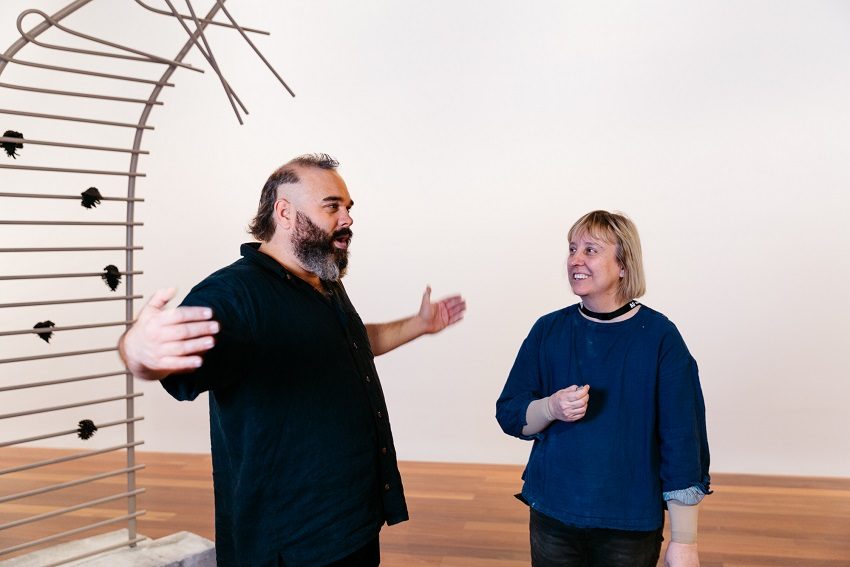Louise Haselton blurs stasis and fluidity

The need to avoid irrelevance, or worse, can lead to innovation and fresh creative insight, writes John Neylon as he reflects on the work of SALA Festival feature artist Louise Haselton.
“Art world, we’ve had a problem here.” “Say again.” “Art World, we’ve had a problem. We’ve had a main Bus Undervolt with conceptual failure.” “OK, we’re working on it.” Sorry. For a moment I was confusing US astronaut Jack Swigert’s tense communication with NASA Mission Control Centre during the Apollo 13 mission, with the behaviour of 1970s contemporary artists. Somewhere in the middle of this dyspeptic misalignment is a roll of duct tape and the sculpture of Louise Haselton.
To understand Haselton’s work is to appreciate art’s ongoing attempts to avoid being extinguished (like the Apollo crew faced with asphyxiation) by the inertia that comes with loss of purpose and absence of tools to meet new challenges. The Apollo crew (and Mission Control) found a “square peg in a round hole” solution by using spare suit hoses and duct tape to make a device that blew used air through a bypass filter into the cabin’s atmosphere.
The Apollo team improvised by using the cardboard log book covers to support the hoses. Duct tape to the rescue again to prevent leaks. One of the crew, Jim Lovell, later wrote in his book Lost Moon, “The contraption wasn’t very handsome, but it worked.” The same might be said about so much contemporary art of the period.

Filling the void created by postwar uncertainty with all kinds of square peg/round hole improvisations including Minimalism, Post Fluxus-based practice, Conceptual Art Neo-Expressionism, Bad Painting, Funk, Video Art Performance, Installation, Earth Art (it’s a long list) to the outer limits of language and gestural statement. Louise Haselton remains a beneficiary of this struggle for meaning and freedom in a mixed up world.
Significantly, the artist didn’t undertake sustained visual arts studies until her late 20s. Her teachers at UniSA (1987–1990) included Steve Wigg, Tony Bishop, George Popperwell and Fiona Hall, whose various sculpture-based practices reflected rigorous conceptual frameworks, inflected with a sense of play and response to materiality. Also of significance in Haselton’s formative development (apart from extensive overseas travel) are studies (1980–83) in education, English literature and comparative religions at the University of Adelaide. From this cross-disciplinary experience stems a nimbleness of creative insight.
Louise Haselton: Act Natural is the 26th publication in the 2019 SALA Wakefield Press monograph series. With its extensive gallery of images documenting Haselton’s evolution as an artist to the present day and comprehensive essays by Gillian Brown and Leigh Robb, complemented by poetic insights by Ken Bolton, it looks more than capable of delivering on the SALA Series’ intention to support ‘emerged’ artists. It is also an opportunity for Adelaide-based writers to spread their wings in the regionally rare upper atmosphere of long-form writing.

Gillian Brown brings a freshness and intent to the task by reflecting on the animist inflections within Haselton’s practice and the writer’s own sense of connection to a Celtic past (Brown comes from Scotland’s north–east). Using the example of standing stones, the writer considers how such items are, on one hand, inscrutable but, on the other, so physically real and often bearing the hallmarks of the hands that made them, that they compel our attention.
At the heart of Brown’s observation is the idea that Haselton’s work speaks of states of equilibrium between a sense of purpose that the artist creates by inventive juxtapositions of objects and materials and the stillness (perhaps muteness?) of the forms themselves.
Brown returns to the standing stones to support this insight, stressing the implacability of such brute objects that are tasked with conversing with whirling stellar constellations above. It’s a vivid analogy. So, hang on to this idea of Haselton’s work as a moment “where the temporal meets the physical, where the balance point between stillness and movement is a pause”.
Other related comment has been made about the artist’s ability to evoke physical states of freedom, bondage, stillness and movement through orchestrated acts of ritualised binding, piercing and interlacing which characterise much of her practice.

Fellow essayist Leigh Robb suggests that Haselton is interested in harnessing the void through inversion. “Her sculptures and installations deftly control emptiness and amplify silence – they hint at hidden spaces. Over 30 years she has achieved this by making works of art which turn the inside out, or, bring the outside in.”
So, there’s another challenging idea to apply to the experience of looking at works which involve using found objects, both natural and artificial (such as sea shells, plastic pegs, drinking straws or metal pots) and combining such materials in ways that blur the distinction between stasis and fluidity. If this prospect looks daunting, approach these sculptures as concrete ikebana – Holocenic accommodations, as fit for purpose as a roll of duct tape and cardboard splints, not always conventionally “handsome” but capable of sustaining life.
A major exhibition by Louise Haselton, like cures like, will be presented at the Samstag Art Museum in parallel with Closer, an exhibition of works by the late South Australian artist Sandra Elms, that underscores the transportive possibilities of the photograph.
Louise Haselton: like cures like
Samstag Art Museum August 2 to September 27
Louise Haselton: Act Natural
Wakefield Press 2019 SALA Monograph, available from August 24